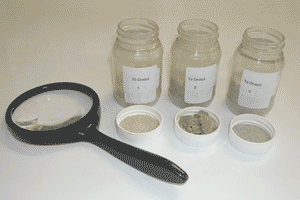|
||||||||||
|
|||||||||
Questions/instructions:
|
|||||||||
| %
responses |
|||||||||
| 1.
I kohia mai ënei momo onepü i ëtahi wähi rerekë
o Aotearoa. Kei hea ngä wähi e taea ana te kohi mai he onepü? Häwhina: He wähi atu anö? These sands were gathered from different places in New Zealand. Where might you go to collect sand? Prompt: Anywhere else? |
ocean
beaches, estuaries, mudflats |
94 |
|||||||
riverbeds,
banks, lakes |
45 |
||||||||
deserts |
4 |
||||||||
places
where there used to be a beach or river (including commercial sandpits) |
0 |
||||||||
quarries
where rock is ground up |
0 |
||||||||
| 2.
Pëhea e puta ai te onepü? He aha te tïmatanga mai? How do you think sand is made? |
by
rocks, stones, shells getting broken up |
38 |
|||||||
Mechanisms: (rubbing against each other – e.g. in river beds; wind action; water/wave action) |
|||||||||
really
good account including at least 2 of these ideas |
4 |
||||||||
mentioned
two ideas |
7 |
||||||||
mentioned
one idea |
12 |
||||||||
| 3.
Äta tirohia ngä onepü. Whakamahia te arotahi hei äwhina
i a koe. He aha i rerekë ai ngä tae o ngä onepü? I want you to have a good look at the sands. Use the hand lens to help you. Why are the sands different colours? |
come
from different types/colours of rock/stone/shell |
13 |
|||||||
vague,
but on right track (come from different places) |
21 |
||||||||
| 4.
He rerekë te rahi o ngä töpata onepü. He aha te take
he rahi ake ëtahi o ngä töpata onepü, he iti ake ëtahi? The sands are different sizes. Why are some pieces of sand big and some pieces of sand small? |
different
materials and different stages of breakdown |
0 |
|||||||
different
stages only |
13 |
||||||||
different
types only |
13 |
||||||||
Total
score: |
8–11 |
9 |
|||||||
5–7
|
17 |
||||||||
2–4 |
40 |
||||||||
0–1
|
34 |
||||||||
| Commentary: Almost all of the students could identify appropriate sources of sand, but only about one third of them could explain how sand is made and why it varies in colour and size. |
|||||||||
| |
||
